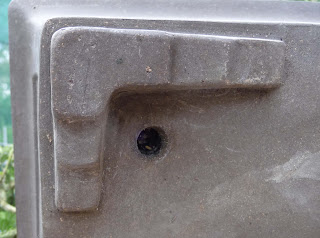As you can see from this picture is has a bit of an arched curvatur
e which is a little more pronounced, but not so much to be a problem aesthetically.
Here is the makers chop. I'm not sure of its origin or what I paid for it. I think it is older than the Tokoname so at least 15 years in service. It has an interesting symbol next to the chop - again any ideas would be gratefully received. I am aware of a Japanese maker who uses a chop with that framed design but I wouldn't be surprised if it was higher end Chinese.
This close up shows the surface. The clay also has quite a bit of granularity. The 'window' relief pattern on the pot wall is not a great piece of workmanship, much like many of the finer details all over the pot, but wholistically from a distance an attractive and useful design.
Here is a detail of the footwork, adequately executed.
All in all not quite the workmanship of the Tokoname. It seems that time was more important than getting the best finish. The arched body could have been managed better, and probably suffered for the same reason. But time was put into some decoration and an attractive foot design. It has been competently executed and ticks of the boxes of timeless design, long term keeper potential and high fired impermeable clay body. This is one that will not be going onto the next society exhibition sale.
Another and final thought for the day is about keeping pot records. Most enthusiasts keep progression photos of their trees which is great to see where you come from. I've done that for years but didn't keep pot records - whatever information available about their source and cost - and now wish I had.



No comments:
Post a Comment
Happy to hear your advice, feedback or questions